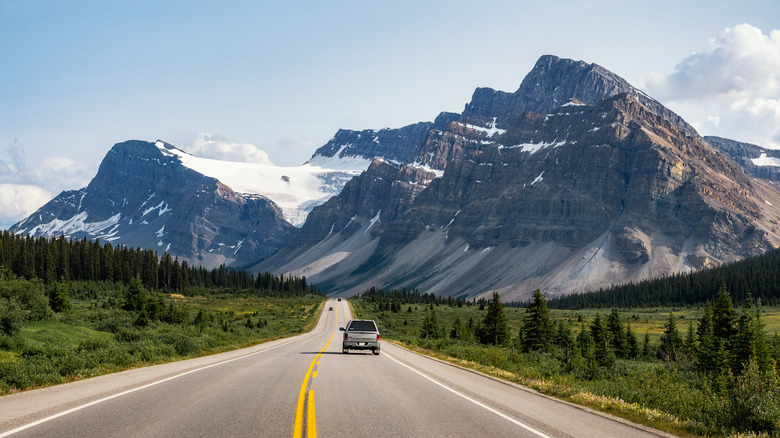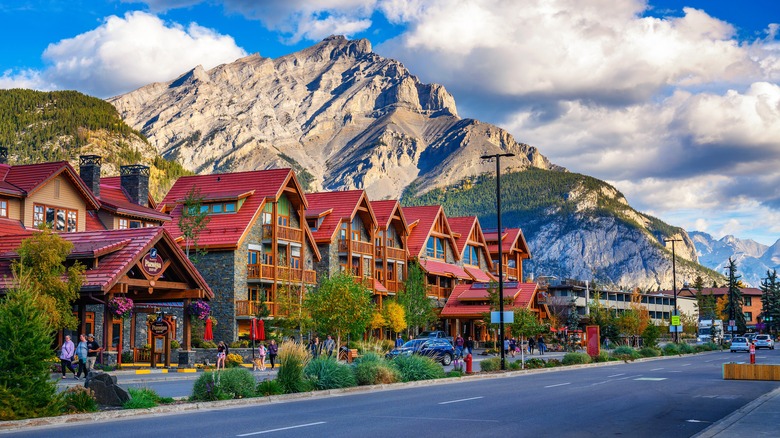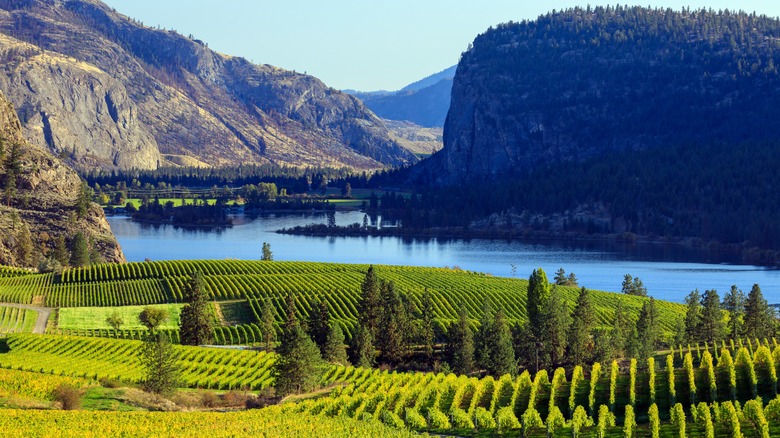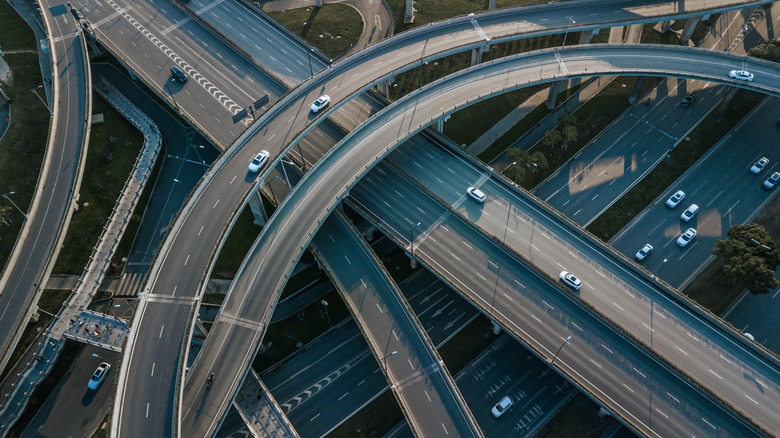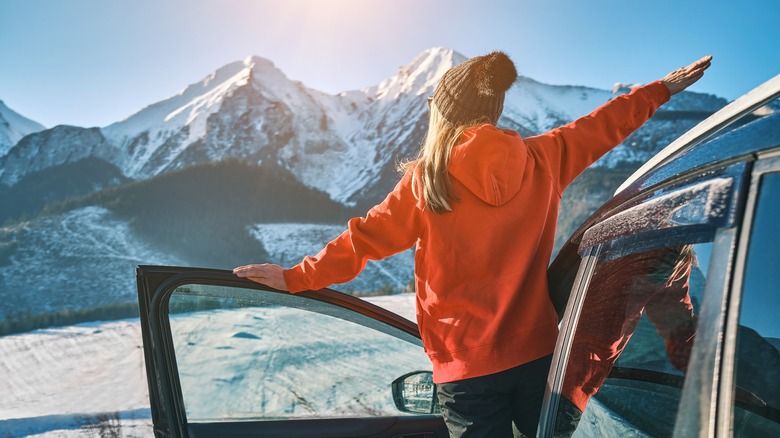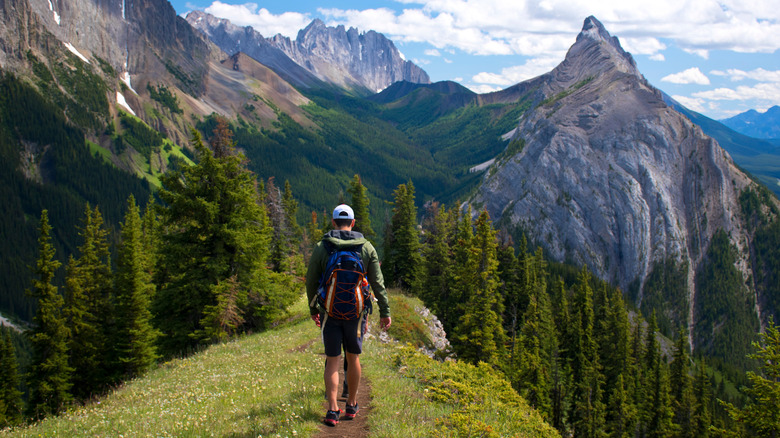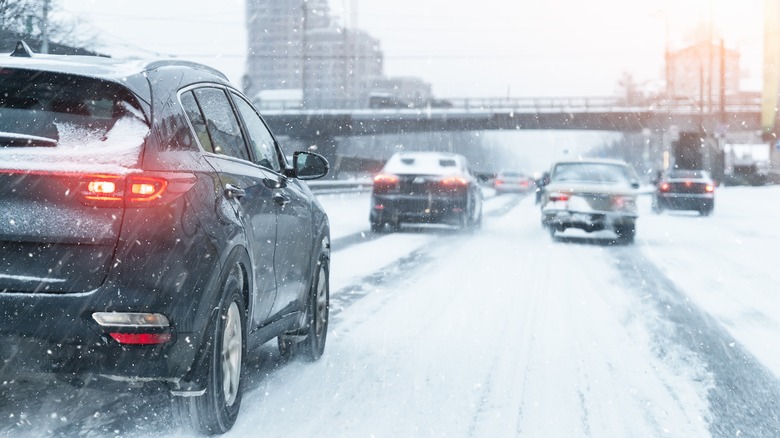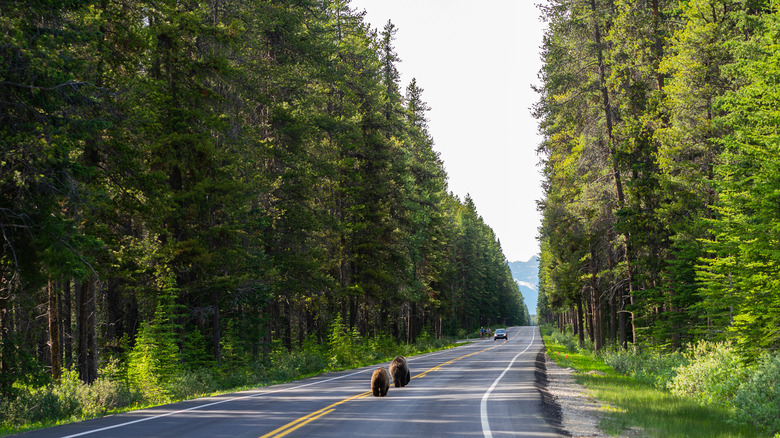An American's Guide To Road-Tripping Through Canada
A road trip is a fantastic way to travel across North America and for those of us nature-inclined travelers, there's no better trip than a road trip through Canada! While there are buses and trains that travel the country, the routes aren't as comprehensive as those you can take by car. Additionally, traveling distances in Canada via public transportation, whether that be across a province or across the entire nation, can be expensive and take a long time. Not to mention, in order to access the best activities, sites, and adventures in Canada (such as hiking the Rockies, beaches, wildlife viewing, etc.) a vehicle is required. Thus, the best way to travel and see the beauty of our northern neighbor is on a road trip!
Before you set off on an epic drive, you'll want to take note of a few things. Canada is similar to the U.S. in that they do drive on the same side of the road (unlike our friends in the U.K. and the rest of the commonwealth) and there are similar laws regarding drinking and driving and cell phone usage. However, there are quite a few differences and quirks regarding laws, signage, and more that could spoil a trip if you don't do your research. Lucky for you, this guide has everything you need to know about road-tripping through Canada.
You have numerous route options across Canada
The first decision and area of research you'll need to complete prior to hitting the great open road is where exactly you want your Canadian road trip to take you. The route options nearly have no end in the Great White North so you'll need to consider your priorities for activities and sightseeing. Do you want to stick to a single province and really explore the area in-depth? Then perhaps drive Alberta's Icefield Parkway through the Rockies, Nova Scotia's Cabot Trail, or Ontario's Lake Superior Loop. Or perhaps you're more inclined to drive from the south to the north on the Yukon's isolated and gravel Dempster Highway for a true wilderness escape.
Cross-country options include, of course, the expansive Trans-Canada Highway. The journey on this road stretches from the far east to the far west of Canada, covering 10 provinces and connecting many of the biggest Canadian cities. The road only skips Yukon, the Northern Territories, and Newfoundland. Along the way, you'll have easy access to stop at great Canadian sites like Jasper, the Prairie Badlands, Toronto, Montreal, Gros Morne National Park, and more. Additionally, sections of this journey can still be completed if you don't have a month plus to spare and just have a few provinces in mind you'd like to visit. Whatever you decide, make sure to consult a map and estimate drive times to make sure your chosen route is logical for your timeframe.
The regions and provinces provide very different road trip experiences
When considering different route options, remember that Canada is a very large country, and the landscape, climate, wildlife, and even language vary across the regions. So if you hope to have a particular experience or see something specific keep all that in mind. The western part of Canada around British Columbia and Alberta is the place to head if you're keen on mountain roads, elevation changes, and epic scenery. If you crave coastal routes where the ocean is never far from view, stick to Vancouver Island or the Atlantic Provinces like Prince Edward Island, Nova Scotia, and Newfoundland.
If you're looking for easy driving, the prairies will be very flat with good visibility. However, the endless wheat fields and blue sky can lull even the most alert driver to sleep, so stay aware (and maybe hit up Tim Hortons for coffee and a snack along the way!) Québec and Ontario will have some of the more brutal winter driving conditions so make sure to check local weather stations. However, both provinces have amazing cottages and lakes, and Québec is home to the lovely Fjord de Sageneuy. The Northern Territories, Nunavut, and Yukon are entirely different kinds of journeys. The roads are often not paved, sometimes covered in ice (and thus only passable in winter), very remote, and have limited services — i.e. not for the faint of heart!
Travel times vary and distances can be deceiving
The worst congestion on your road trip will always be in cities, the largest ones in particular. The worst bottlenecks can mostly be found in Toronto. Montreal's Highway 25 between Avenue Souligny and Rue Beaubien Est can be particularly bad, as this city and the entire province of Québec are infamous for constant construction that never seems to end, due to having what has been called some of the worst roads in the country. In Vancouver, avoid Granville St at SW Marine Dr and W Georgia St between Seymour St and W Pender St if possible.
If you're not driving much in cities, you can still run into obstacles and literal roadblocks. You might think to yourself "Oh Vancouver to Kelowna, that's about four hours" and then run into construction, rock falls, or downed trees that result in road closures that add a couple of hours to your drive. The mountains are famously unforgiving in this respect and so are the unpaved roads up in northern Canada, so always make sure to monitor local news for the most up-to-date information.
Rental cars, gas, and other costs
Like most of the U.S., you'll need to be at least 21 years old to rent a car in Canada. However, those between the ages of 21 and 24 will often be charged an additional 'young driver' fee and may be restricted to the type of car that they can rent. It's simpler and often much cheaper to rent a car if you're 25 or older, so if you're a duo or group and someone is older, consider having them be the driver. Additionally, you'll need to have held a license for at least a year in order to rent a car in Canada, so if you just passed your test six months ago (no matter what age you are), you'll need to wait. A credit card is mandatory at all car rental agencies and typically needs to match the name of the driver. It's also a good idea to bring your passport as well, as you may be asked for additional identification.
Rental car costs are on par with the U.S., so don't expect any surprises there. However, gas can be a bit more expensive in Canada. So if you're plannig a route that takes you across the border at all, consider refilling the tank in the U.S. Tolls aren't very common in Canada, so don't stress about factoring those into your budget.
Driving laws vary across the country
Just like various road and driving laws that vary from state to state in the U.S., regulations can be different in Canada and across the provinces. Similar to the U.S., you must come to a full stop at stop signs and red lights, pedestrians have the right of way, and seat belts must be worn. If you wish to use a cell phone, you must have a hands-free device. One important tip is, in general, you can take a free right turn at red lights, except in Montreal, where it's not allowed. However, in the rest of Québec and Canada, it's completely legal. Another Québec-specific quirk is that stop signs in the province won't typically say "stop" but rather the French word, "arrêt", or occasionally you'll see a bilingual sign.
In British Columbia, a flashing green light indicates that the pedestrian crossing has been activated. However, in Ontario, the flashing green light is to direct drivers turning left, so make sure to double-check when switching provinces. And in most major cities, pay attention to parking signs, as there are often different rules for winter and summer seasons due to snow removal. Additionally, remember the speed limits are in kilometers (the speedometer will be too if you're renting a car), and frequently monitored by radar. You'll also be required to have insurance when renting a car in Canada. Many U.S. policies will also cover you in Canada, but if not, you can purchase a policy with the rental company.
Drivers also vary across provinces
By now, you're likely aware that the landscape, weather, language on road signs, and traffic lights can differ widely across Canadian provinces. Another aspect you might want to factor in is who you're sharing the road with while traveling throughout the country. Just like the U.S. has stereotypes regarding those behind the wheel across the states, Canada does too. Those in British Columbia have been deemed the worst and are considered the Canadian equivalent of LA drivers. They are frequently cited as not being good about signaling and frequently tailgating and speeding, so keep that in mind if you're planning a west coast trip.
Additionally, rolling through a stop sign is referred to as a "Quebecer-stop" rather than a "California stop. While the French Canadians aren't as aggressive as those out west, be prepared for extra vigilance, especially in Québec winters. Those in the Atlantic provinces are considered to be much more passive and may drive actual California drivers crazy with their relaxed approach. The Northwest Territories and Yukon can be a free-for-all with the lack of paved roads and lack of population.
Activities and sites across Canada to consider when planning
Another factor you may want to consider on your Canadian road trip are what you want to do and see when you're not actively driving. Canada is a nature-oriented country in general, but if you want to prioritize the best hiking over city visits or fjords and beaches, it's best to pass through the appropriate provinces. British Columbia and Alberta hiking, camping, backpacking, skiing, and other outdoor activities will take place among the best mountains in the country (and arguably some of the best on the continent.) If you want lake time, much of the country will work, just maybe avoid the southern prairies. If you want to hit small coastal towns, stick to the Atlantics. If big cities are your thing, aim to visit Vancouver, Toronto, or Montreal, as most other Canadian cities are quite small. If you want to see where the famous Canadian maple syrup is produced, stick to Québec. If wine tasting is a priority, try Eastern British Columbia, Prince Edward County, or the Niagara Peninsula, Ontario.
Whale-watching and fishing can be done wherever there's water. But, if you have particular types in mind you want to see, plan accordingly. Orcas can be seen out west, as Vancouver Island is particularly good viewing. Newfoundland and Labrador are great places to see Humpback whales and Tadoussac, and Québec is home to about 13 species. Belugas (and polar bears) are found in Churchill, Manitoba.
Important tools and supplies
Google Maps is great (except when it isn't and you end up on a road to nowhere), but you'll also want to consider other helpful tools on your Canadian road trip. Waze can be very helpful in avoiding congestion and finding new routes on the fly. It's also a good idea to bring a paper map (or two) with you as large parts of Canada, particularly in parks and remote areas, won't necessarily have cell service or GPS reception. There's nothing worse than getting lost somewhere without good road signage (or in Québec, when you don't read French) and having no idea which way to go. TransCanadaHighway.com is a great resource for those traversing the country for up-to-date traffic. If you have more of a regional trip, check local provincial news stations.
It's also recommended to keep a small snow shovel and windshield scraper in the car for most months barring summer. So, if you're driving on your own across the border, make sure to purchase both if you don't already have them. If you're renting a car in Canada, they'll likely provide these, but make sure to ask. Additionally, if you are traveling between October/November and April, you'll want winter tires or chains. If crossing mountain passes one or the other will be required. Again, rental companies should provide the necessary equipment but always double-check. Also, main highways can have large stretches without service, so make sure you have spare tires, a gas tank, plenty of water, and a car or portable charger for electronics.
The weather can be a huge factor and changes on a dime
Canada is typically thought of as a winter wonderland, and for over half the year in most of the country, that's pretty accurate. The cold and snowy season can begin as early as November in many places and last through April. It's not unheard of to have a beautiful spring day and then wake up the next morning to a late spring snowstorm. So, if you're coming from California and Texas and just assume the snow will have all melted by early March, think again.
The weather really becomes a factor if you're heading far north or driving through the mountains, so make sure to check the weather and road closure reports vigilantly. In the spring, you'll want to keep in mind that some parts can see very heavy rain and are at risk of flooding and road washouts. In summer, the western part of the country can erupt in wildfires (and more so as climate change intensifies). Not only do the fires pose a safety concern, but air quality can deteriorate significantly from the smoke — even hundreds of miles from the burns. Make sure to monitor local news and weather in the province and/or the region you're traveling in, no matter the season.
You'll need to mind the wildlife in much of Canada
Similar to how the country is typically thought of as a snowy paradise, it's also considered the epitome of nature and wilderness for many. And while wildlife viewing is definitely one of the main highlights on any road trip through Canada, you'll need to keep a few things in mind regarding animals. Depending on where you travel within the country, you'll encounter different creatures.
Bears roam through most provinces, but Grizzlies are primarily found in British Columbia and the western providences. Polar bears are found much further north in the Territories and Churchill, Manitoba, although neither of those is really a road-tripping destination. Black and brown bears can be found in most provinces bar Prince Edward Island. The iconic moose of course is widespread, especially in Newfoundland, although they aren't found on Vancouver Island or the Arctic. Buffalo can still be found in the prairies and skunks are found all over Central and Eastern Canada. Remember dawn and dusk are the prime times for animal activity, so be extra careful during those times.
In a country this expansive, rest stops will be your best friend
Whether you're driving across Saskatchewan, across the Atlantic provinces, or across all of Canada, remember that the country is huge. Drives will take a while and often longer than you may think due to construction, road closures, wildlife, or the weather. So, road fatigue can quickly set in. If you're driving as a pair or group, try and switch drivers every few hours and make sure passengers check in with the one behind the wheel frequently. Another good tip is to map out the rest areas you'll pass by in advance, as they're plentiful and frequent on most major highways. While you won't find any luxury facilities, there are usually bathrooms (any road-tripper through Canada's holy grail!), and a few picnic tables. Depending on where you are there may be a nice view, too, such as in the Rockies or coastal routes.
Planning ahead is always a good idea in case there's a long stretch where you won't encounter any stops. That way, you can plan to exit and find a gas station or cafe to pull over, rest, maybe swap drivers, and ideally refuel with some caffeine! Also, don't forget to take note of the service station signs, which will often tell you how far until the next rest area. On more remote highways (particularly in the north) you'll want to fuel up as frequently as possible and consider filling up an extra canister for emergencies. And always have plenty of water and a few snacks as well.
